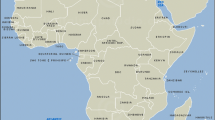Abstract
This study assessed the health risk and quality of non-roof-harvested rainwater in an oil-producing community in Edo South, Nigeria. Standard analytical procedures, atomic absorption spectrophotometry and pour plate technique were utilized in the determination of physico-chemical, heavy metals and microbial parameters, respectively. Human health risk was estimated using US EPA risk assessment methodology. The pH ranges from 3.55 to 6.62 which indicated acidic rainwater; sulphate and nitrate had a range of 5.6 to 36.8, 0.11 to 0.77 mg/l and 0.2 to 0.93 mg/l, respectively. Iron and lead concentrations ranged from 0.27 to 1.79 mg/l and 0.0 to 0.025 mg/l, chromium concentrations ranged from 0.0 to 0.028 mg/l and cadmium concentrations ranged from and 0.0 to 0.021 mg/l. The total heterotrophic bacterial and total fungal counts ranged from 0.5 to 2.0 × 10 cfu/ml and 0.0 to 2.2 × 10 cfu/10 cfu/ml, respectively. The total coliform counts ranged from 2 to 12 MPN/100 ml. Health risk assessment result showed that the hazard risk from ingestion of cadmium with rain water from studied locations was 5 × 10−6. The findings therefore suggest that there should be increased awareness about the health hazards associated with continuous intake of non-roof-harvested rain water from areas with polluted atmosphere.



Similar content being viewed by others
References
Achadu, O. J., Ako, F. E., & Dalla, C. L. (2013). Quality assessment of stored harvested rainwater in Wukari, North-eastern Nigeria: impact of storage media. IOSR Journal of Environmental Science, Toxicology and Food Technology, 7(5), 25–32.
APHA. (1998). Standard methods for examination of water and wastewater (19th ed.). Washington, D.C.: American Public Health Association, American water Works Association and Water Pollution Control Federation.
Barnett, H. L., & Hunter, B. B. (1972). Illustrated genera of imperfect fungi (3rd ed.). Minneapolis: Burges Publishing Company.
Cheesbrough, M. (2004). District laboratory practice in tropical countries. Low price edition part 2. England: Cambridge press.
Collins, C. H., Lyne, P. M., Grange, J. M., & Falkinham, J. O. (2004). Collins and Lyne’s microbiological methods (8th ed.). London: Arnold Pub 465 pp.
Cullimore, D. R. (2000). Practical atlas for bacterial identification. Boca Raton: CRC Press 209 pp.
Efe, S. I. (2010). Spatial variation in acid and some heavy metal composition of rainwater harvesting in the oil-producing region of Nigeria. Natural Hazards, 55(2), 307–319.
Ezenwaji, E. E., Okoye, A. C., & Otti, V. I. (2013). Effects of gas flaring on rainwater quality in Bayelsa State, Eastern Niger-Delta region, Nigeria. Journal of Toxicology and Environmental Health Sciences, 5(6), 97–105.
Igwo-Ezikpe, M. N., & Awodele, O. (2010). Investigation of some physico-chemical and microbiological parameters in rainwater collected from industrial areas of Lagos state, Nigeria. African Journal of Pharmaceutical Sciences and Pharmacy, 1(1), 26–38.
International Agency for Research on Cancer. (2004). Some Drinking-Water Disinfectants and Contaminants, Including Arsenic. In IARC Monographs on the Evaluation of Carcinogenic Risks to Humans. Lyon: International Agency for Research on Cancer 84, Available online: http://monographs.iarc.fr/ENG/Monographs/vol84/mono84.pdf. Accessed 5 June 2015.
Mukoro, E. E., Agunbiade, S., & Yakubu, M. (2015). Hydraulic relationships of the Ikpoba River for flood studies. Civil and Environmental Research, 7(7), 61–67.
Naveedulah, H. M. Z., Yu, C., Shen, H., Duan, D., Shen, C., Luo, L., & Chen, Y. (2014). Concentrations and human health risk assessment of selected heavy metals in surface water of the siling reservoir watershed in Zhejiang Province, China. Polish Journal of Environmental Studies, 23(3), 801–811.
Olabaniyi, S. B., & Owoyemi, F. B. (2006). Characterisation by factor analysis of chemical Facies of groundwater in the deltaic Plain Sands aquifer of Warri, Western Niger Delta. Unesco/African Journal of Science and Technology: Science and Engineering Series, 7(1), 73–81.
Olobaniyi, S. B., & Efe, S. I. (2007). Comparative assessment of rainwater and groundwater quality in an oil producing area of Nigeria: environmental and health implications. Journal of Environmental Health and Research, 6(2), 111–118.
Pandey, A., & Singh, A. (2012). Chemical characterization of rain water in a seasonally dry tropical region (Varanasi), India. Journal of Environmental Biology, 33, 629–634.
World Health Organization, WHO. (2004). Guidelines for Drinking Water Quality. In Recommendation (Vol. 1, 3rd ed., p. 18). Geneva: World Health Organization.
Author information
Authors and Affiliations
Corresponding author
Additional information
Publisher’s note
Springer Nature remains neutral with regard to jurisdictional claims in published maps and institutional affiliations.
Rights and permissions
About this article
Cite this article
Imarhiagbe, E.E., Osarenotor, O. Health risk and quality assessment of non-roof-harvested rainwater from an oil-producing community in Nigeria. Environ Monit Assess 192, 169 (2020). https://doi.org/10.1007/s10661-020-8102-z
Received:
Accepted:
Published:
DOI: https://doi.org/10.1007/s10661-020-8102-z




